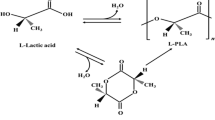Abstract
Poly(ε-caprolactone) has become an important biocompatible and biodegradable polymer. Indeed, due to its multiple biomedical applications, the synthesis of polycaprolactone has received increased attention in the past few decades. Moreover, microwave irradiation is a very clean modern technique widely used for green chemistry. Here, several polymers were synthesized by microwave irradiation, without any solvent, using nontoxic, biologically acceptable lanthanide halides as initiators. Reaction times varied between 2 and 90 min. The molecular weights of the obtained polymer products were between 3,000 and 16,000 g/mol. After polymerization, the polycaprolactone polymers were functionalized by reaction with 2-hydroxyethyl methacrylate. Hydrolytic and enzymatic degradation of the synthesized polymers were compared and discussed.





Similar content being viewed by others
References
Agarwal S, Karl M, Anfang S, Dehnicke K, Greiner A (1998) Synthesis and characterization of homopolymers and copolymers based on ε-caprolactone and δ-valerolactone using organolanthanides. Polym Prepr 39:36–362
Baghurst DR, Mingos DMP (1992) Superheating effects associated with microwave dielectric heating. J Chem Soc Chem Commun 9:674–677
Barakat I, Dubois P, Jerome R (1991) Living polymerization and selective end functionalization of ε-caprolactone using zinc alkoxides as initiators. Macromolecules 24:6542–6545
Barbier-Baudry D, Bouazza A, Brachais CH, Dormond A, Visseaux M (2000a) Lanthanides benzimidinates: initiators or real catalysts for the ε-caprolactone polymerization. Macromol Rapid Comm 21:213–217
Barbier-Baudry D, Dormond A, Richard S, Desmurs JR (2000b) UraniumIV and uranyl salts, efficient and reusable catalysts for acylation of aromatic compounds. J Mol Cat A Chem 164:195–204
Chemat F, Esveld E (2001) Microwave super-heated boiling of organic liquids: origin, effect and application. Chem Eng Technol 24:735–744
Duda A, Penczek S (1995) Polymerization of ε-caprolactone initiated by aluminum isopropoxide trimer and/or tetramer. Macromolecules 28:5981–5992
Evans WJ, Katsumata H (1994) Polymerization of ε-caprolactone by divalent samarium complexes. Macromolecules 27:2330–2332
Fang X, Huang S, Scola D (1998) Ring opening polymerization via microwave irradiation. Polym Mater Sci Eng 79:518–519
Fang X, Hutcheon R, Scola D (2000) A study of the kinetics of the microwave cure of a phenylethynyl-terminated imide model compound and imide oligomer (PETI-5) J Polym Sci Part A Polym Chem 38:1379–1390
Kricheldorf HR, Hauser K (1998) Macrocycles. 3. Telechelic polylactones via macrocyclic polymerization. Macromolecules 31:614–620
Liu Y, Schulze M, Albertsson AC (1998) α-methacryloyl-ω-hydroxyl-poly(ε-caprolactone) macromonomer: synthesis, characterization, and copolymerization. J.M.S Pure Appl Chem A35:207–232
Loupy A, Petit A, Hamelin J, Texier-Boullet F, Jacquault P, Mathé D (1998) New solvent-free organic synthesis using focused microwaves. Synthesis 9:1213–1234
Okuda J, Koenig P, Ngo S, Rushkin I (1994) Ring-opening polymerization of lactones by mono(cyclopentadienyl)titanium complexes. Polym Prepr 35:524–525
Shen Y, Shen Z, Shen J, Zhang Y, Yao K (1996) Characteristics and mechanism of ε-caprolactone polymerization with rare earth halide systems. Macromolecules 29:3441–3446
Stevels WM,. Ankoné M, Dijkstra P, Feijen J (1996) A versatile and highly efficient catalyst system for the preparation of polyesters based on lanthanide tris(2,6-di-tert-butylphenolates) and various alcohols. Macromolecules 29:3332–3333
Stuerga D, Gaillard P (1996) Microwave athermal effects: a myth's autopsy. Part I. Historical background and fundamentals of wave-matter interaction. Part II. Orienting effects and thermodynamic consequences of electric field. J Microwave Power Electromagn Energy 31:87–113
Visseaux M, Brachais CH, Boisson C, Tortosa K (2000) Nitrogen-containing lanthanide complexes: initiators or real catalysts for the ε-caprolactone polymerization. C R Acad Sci Paris, Serie IIc, Chimie 3:631–638
Author information
Authors and Affiliations
Corresponding author
Rights and permissions
About this article
Cite this article
Barbier-Baudry, D., Brachais, L., Cretu, A. et al. Synthesis of polycaprolactone by microwave irradiation — an interesting route to synthesize this polymer via green chemistry. Environ Chem Lett 1, 19–23 (2003). https://doi.org/10.1007/s10311-002-0005-4
Accepted:
Published:
Issue Date:
DOI: https://doi.org/10.1007/s10311-002-0005-4




